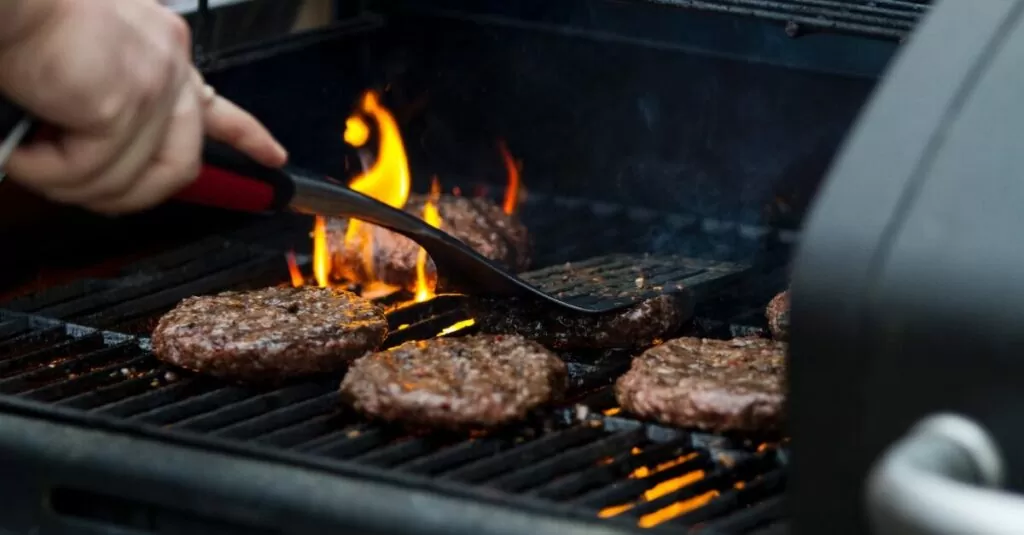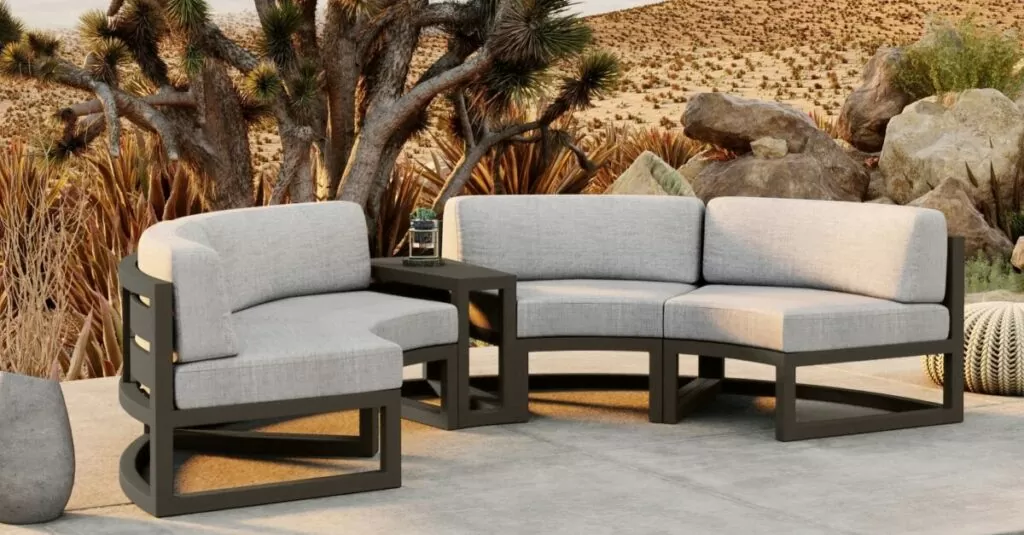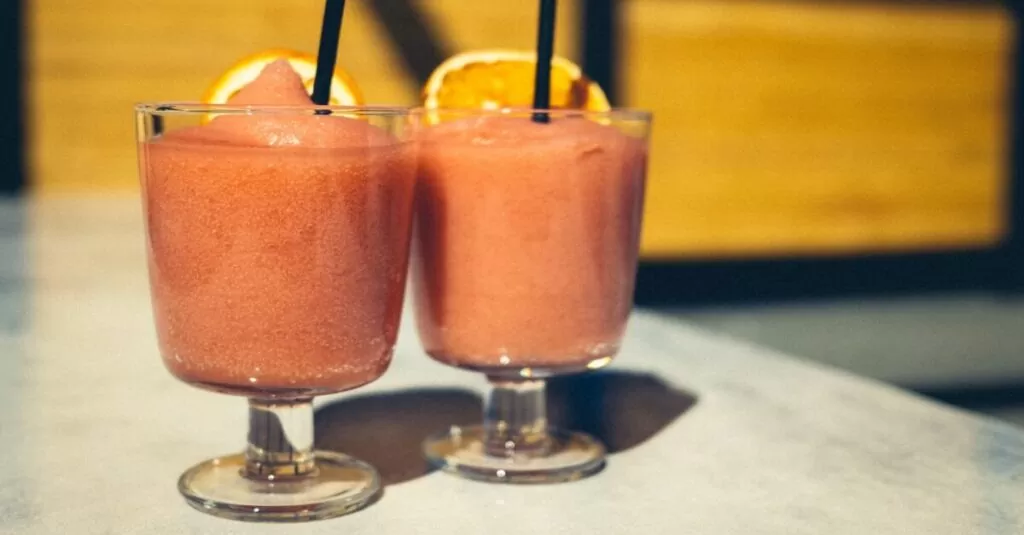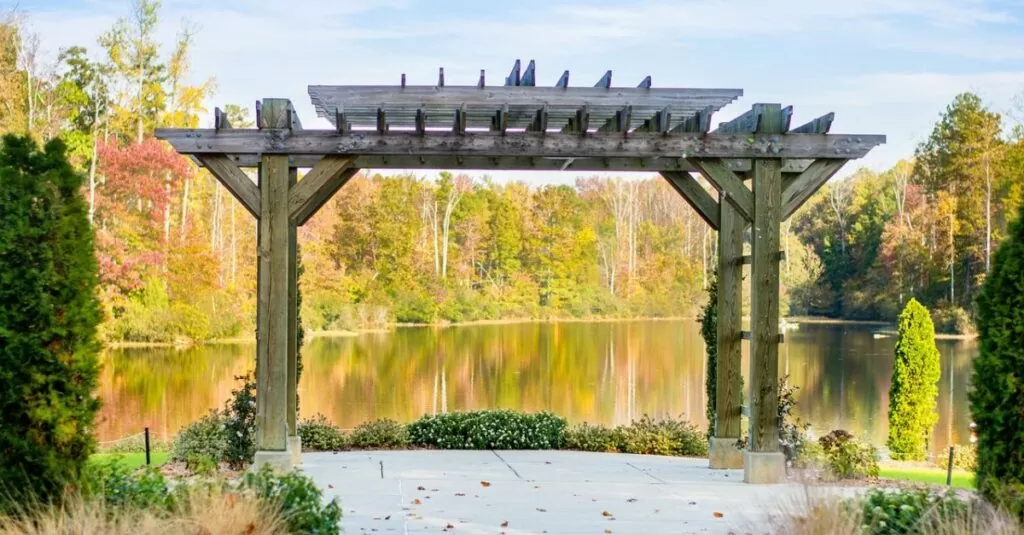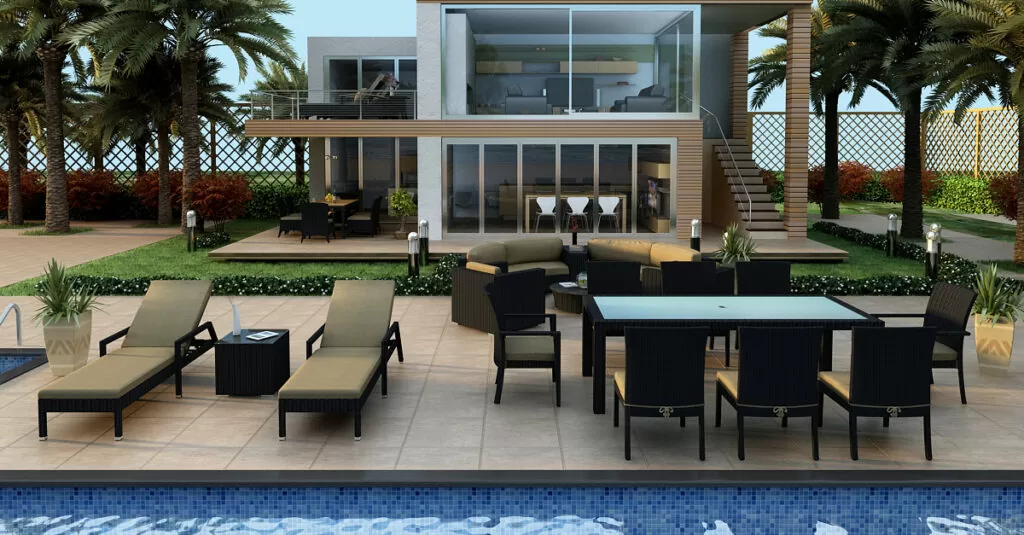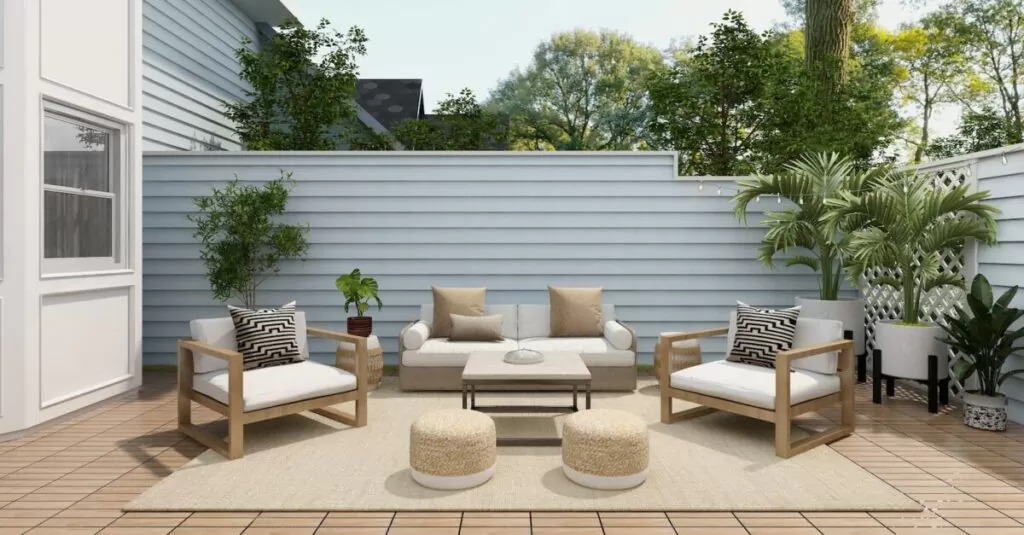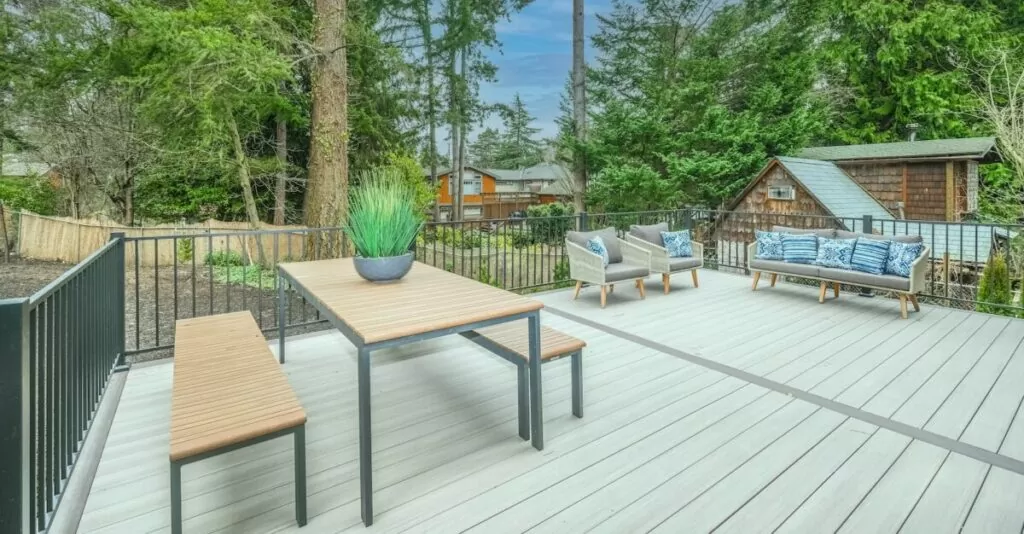Hey friends! If you’re looking to spruce up your outdoor space with some stylish and durable patio furniture, you absolutely need to consider wicker. I wish I knew about wicker YEARS ago when I first started decorating my patio – it would have saved me tons of time, money, and frustration with flimsy outdoor furniture!
Today, I’m sharing everything I’ve learned about outdoor wicker so you can avoid the mistakes I made. Get ready to become a wicker wizard!
Key Points
- Outdoor wicker is fade, crack, and mildew resistant, making it perfect for outdoor use. The synthetics like polyethylene mimic the look of natural wicker while being weatherproof.
- Quality resin wicker is woven tightly over aluminum frames. Avoid cheap steels frames that can bend and rust over time.
- Look for comfort features like thick cushions and curved shapes. Deep seating sectionals are worth the investment.
- Measure your patio carefully and buy appropriately sized wicker patio furniture with some clearance for walking around.
- With proper care, synthetic wicker lasts 4-7 years on average. Higher-end pieces can last over a decade!

First: Want more patio furniture shopping tips? be sure to check out our Complete Patio Furniture Buyer’s Guide to help you with all your furniture buying needs.
What is Outdoor Wicker?
Traditional, all-natural wicker is woven from natural plant materials like rattan, reed, and (in some cases) abaca hemp. While beautiful, these materials degrade quickly outside.
Outdoor wicker utilizes woven man-made fibers like high-density polyethylene (HDPE) that are specially formulated to be weatherproof. It provides the same gorgeous, natural look of wicker without any of the downsides!
Other terms you may hear for outdoor wicker include synthetic wicker, resin wicker, all-weather wicker, and polyethylene wicker. These are all the same thing – HDPE wicker made for year-round outdoor use. Don’t be fooled – high-density polyetheylene is the gold standard for durability and environmental safety. A lot of cheaper brands will opt for PVC wicker instead, because it costs much, much less to produce. But PVC is far more brittle than HDPE and does not hold up well to water exposure and long term sun damage. If you want to buy something that lasts more than a season or two, buy HDPE wicker, not PVC. To add to the confusion, there’s also Polypropylene, or “PP”. This stuff is not great either. I’ll discuss the differences between these materials further down.
Benefits of Outdoor Wicker Furniture
There are so many reasons to love outdoor wicker furniture! Here are some of my favorite perks:
- Fade resistant – The color won’t dull or bleach out from sun exposure
- Crack resistant – Won’t become brittle and split like natural wicker
- Mildew resistant – Repels moisture and won’t develop mold
- Easy to clean – Just needs occasional wiping down or hose washing
- Lightweight – Sets weigh under 100 lbs total so they’re portable
- Affordable – Cheaper than natural wicker and other patio furniture options over the long run
- Comfortable – Features thick cushions in weatherproof fabrics
Synthetic wicker is the whole package – stylish, comfy, AND durable for your outdoor oasis!

Types of Wicker Furniture
You can find just about any type of furniture nowadays with an outdoor patio wicker makeover. Some popular categories include:
- Dining sets – Oval, rectangular, and round wicker dining tables with 4-6 chairs
- Lounge sets – Loveseats, club chairs, ottomans perfect for conversation areas
- Sofa sets – Sectionals, sofas, and loveseats that create comfy hangout spaces
- Chaise lounges – Adjustable chaise lounges and daybeds that come solo or as part of sectionals
- Bar sets – Tall bar tables with coordinating stools for outdoor entertaining
- Bistro Sets – 1 or 2 bistro chairs with a coordinating small table, perfect for smaller areas
Dining and sofa lounge sets are the most common, but wicker works great on just about any type of patio furniture. Let your imagination run wild!
What to Look for When Buying Patio Wicker Furniture
The quality of wicker pieces can vary quite a bit, so it helps to know what features to look for. Here are the main factors to keep in mind:

Frames
The inner frames provide structural support. Aluminum is the best choice since it won’t rust or corrode like steel. Make sure to inspect frames for sturdy welded construction.
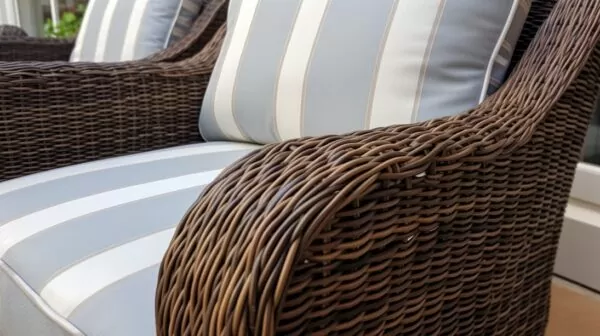
Weave
The synthetic fibers should be woven tightly with lots of texture and natural variation. Avoid pieces with large gaps or perfectly smooth, shiny strands.
Fabric
For the cushions, look for Sunbrella fabric. They will resist fading and are suitable for outdoor use.
Weather Resistance
Quality outdoor wicker holds up to full sun, rain, snow, and humidity without degradation. Verify waterproofing and UV protection.
Warranty
At minimum, you want a 1 year warranty on the frame and 2 years on the cushions. Higher-end pieces often come with 3-5 year warranties.
Comfort
Plush cushions and ergonomic shaping make a huge difference in comfort. More than 50% of the cost of a wicker set is in the cushions. If you see a cheap wicker set somewhere, it is probably made of PVC and has cheap cushions that will not last much more than a year.

durable, authentic-looking HDPE resin wicker
Synthetic Wicker vs. Natural Wicker
How does synthetic wicker stack up to traditional, natural wicker? Here’s a quick comparison:
| Synthetic Wicker | Natural Wicker |
|---|---|
| Weather resistant | Prone to sun damage and fading |
| Mold/mildew resistant | Can develop mold if moisture gets trapped |
| UV protection added | No UV protection |
| Textured and colorfast 5+ years | Textured fibers can become smooth over time |
| Stays rigid | Can become less rigid over years |
| Requires no seasonal storage | Needs seasonal storage or will degrade faster |
While natural wicker has an undeniable beauty, its delicate nature just doesn’t work well in outdoor settings long-term. Resin outdoor wicker gives you the beauty of wicker with added toughness.
How Long Does Wicker Furniture Last?
With proper care and maintenance, you can expect quality outdoor wicker furniture to last anywhere from 4-7 years on average. Higher end pieces often last over a decade!
The weave will show wear before the frame gives out, so your furniture won’t suddenly collapse on you. Outdoors, the synthetic fibers will slowly lose some texture and the color will begin to fade after several years of exposure.

Caring for Your Wicker
Looking after your resin patio wicker properly ensures it stays beautiful year after year. Here are my top care tips:
- Rinse with water occasionally to prevent dirt buildup and debris getting trapped. Allow to air dry.
- Check for loose or damaged strands and re-weave or glue back into place if needed.
- For deeper cleaning, use mild soap and warm water with a soft bristle brush. Avoid harsh chemicals.
- Apply protective formula made for outdoor wicker once or twice a year. This resists moisture and UV damage.
- Use furniture covers when not in use for long periods.
- Fluff and rotate cushions regularly to maintain shape and even wear.
- Wash cushions on gentle cycle using mild detergent. Air dry only.
With the right care, your wicker patio set will stay gorgeous season after season! I speak from experience – my very first wicker set is still going strong after 7 years!
What’s the Best Synthetic Wicker Material?
If you start reading about different synthetics used to make wicker, it can get confusing fast. Here’s a quick 101:
- High-Density Polyethylene (HDPE) – This is the gold standard for outdoor wicker. It’s colorfast, durable, and weatherproof for decades. Made from ethylene gas.
- Polyvinyl Chloride (PVC) – Cheaper option but degrades faster. Can become brittle when exposed to sunlight. Avoid.
- Polypropylene (PP) – Very resistant material but not as flexible as PE for weaving. Usually used for frames.
- Resin – Catchall term for synthetic wicker material. Can be made from PE, PVC, etc. Ask for specifics.
I recommend HDPE wicker as it has the longest lifespan outdoors and is recyclable. Steer clear of furniture labeled “100% resin wicker” as it’s likely cheap PVC.

is all-weather, recyclable, and resistant to fading or cracking.
What’s the Deal with Rattan vs Wicker?
If you’ve done any patio furniture research (like me!), you’ve probably come across both “wicker” and “rattan” used to describe similar furniture styles. What gives?
Rattan and wicker refer to two different parts of the furniture:
Rattan – Name for over 600 species of palm vines. Used to make wicker furniture frames.
Wicker – Technique of weaving flexible strands into furniture pieces. Originally used natural fibers like rattan.
So rattan refers to the material, while wicker describes the weaving method. Rattan was the OG natural wicker material back in the day. Now, synthetic wicker uses man-made fibers like PE but with the same woven technique.
The more you know!
Outdoor Wicker Furniture Price Points
Outdoor wicker spans the budget spectrum so you can always find options to suit your space and price range! Here’s what to expect:
Budget ($1000 – $2000) – Individual chairs, small bistro sets, basic construction. Best for occasional use.
Mid-Range ($2000 – $4,000) – Most common 3-5 piece dining sets and sofa sets. Great everyday quality.
High-End ($4,000 +) – Oversized sectionals, premium details and fabrics. Investment pieces.
Harmonia Living is a great brand that gives you high-end quality for a mid-range price and is our best-selling brand for wicker furnishings.
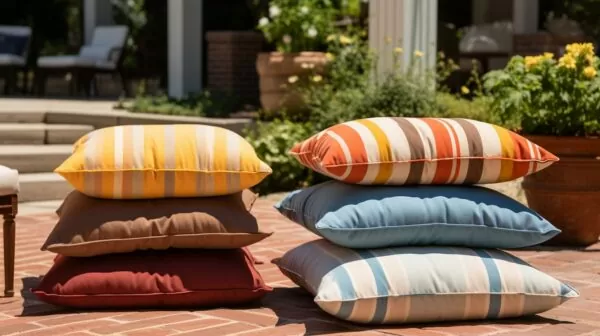
Maintaining Your Outdoor Fabric Cushions
Outdoor fabric on wicker cushions takes a real beating from sun exposure, dirt, and regular use. Here are my top tips for keeping cushions looking fresh:
- Flush regularly – Fluff and rotate cushions to prevent sagging and indentations from forming.
- Use cushion covers – Zippered cushion covers protect from dirt, rain, and UV when not in use.
- Wash periodically – Every few months, wash on gentle cycle using mild detergent and air dry.
- Protect in winter – Bring cushions indoors or keep covered when not using furniture for winter months.
- Spot clean spills – Immediately spot clean any spills before staining can occur.
- Repair damage – Patch small holes or tears with fabric glue to prevent further ripping/damage.
Don’t be afraid to invest in quality outdoor fabric like Sunbrella. The years of extra life are worth the higher price tag.
Mixing Materials for Eclectic Style
One of my favorite patio design tips is mixing different materials to create an eclectic, collected style. Wicker pairs beautifully with other outdoorsy elements like:
- Cast aluminum bistro sets
- Teak wood side chairs, benches, or side tables
- Wrought iron, cast aluminum accent pieces
- Ceramic, terra cotta planters
- Fire pits, chimineas, and fire tables
- Hammocks, swings, and hanging chairs
- Raised garden beds and vertical planters
Blending the natural texture of wicker with other materials outdoors makes spaces feel curated. Have fun and get creative with your combinations!
Style Ideas for Patio Wicker Furniture
The styling versatility of wicker is one of my favorite things about it! It works with any patio decor style you can dream up. Here are some of my favorite ways to incorporate wicker furniture:
Contemporary – For modern spaces, choose wicker in darker hues like espresso or black. Add sleek lines, metal accents, and crisp cushions.
Traditional – Lean into classic elegance with neutral tones, curved silhouettes, and vintage-inspired cushion patterns.
Tropical – Weave in bright colors and botanical prints. Accent with palms, rattan ceiling fans, and ceramic garden stools.
French Country – Weathered finishes, painted frames, and checkered cushions evoke Provence style. Add urns and olive trees.
Coastal – Light blue and white color schemes with weathered wicker and vintage nautical accents are perfect for waterfront homes.
Let your imagination run wild – the possibilities are endless! Don’t be afraid to take risks and have fun with your style.

FAQs about Wicker Furniture
Still have some lingering questions? Here are answers to some of the most common FAQs about wicker furniture:
How do you clean synthetic wicker?
Use a soft bristle brush, mild soap, and warm water. Avoid harsh chemicals or pressure washing.
How long does HDPE wicker last outside?
10-15 years with proper care and maintenance. Fading and texture loss occur gradually.
Can synthetic wicker go in the rain?
Yes! Synthetic wicker is waterproof and won’t be damaged from rain, snow, or humidity.
What is the best wicker material for outdoors?
Polyethylene (HDPE) wicker has proven superior durability against sun, rain, cold, and salt air.
Is resin wicker good quality?
“Resin” is vague – make sure it specifies polyethylene resin for optimal quality and durability.
Should I cover my wicker patio furniture in the winter?
Covering protects from snow accumulation and makes spring cleaning easier. But it’s not required.

resilient, and adds class to every outdoor space.
Final Thoughts
Well friends, we made it! By now you should be a wicker expert, armed with all the knowledge you need to find your perfect outdoor wicker furniture!
The bottom line: Look for all-weather polyethylene wicker, aluminum frames, quality fabrics, and comfort-focused design in your budget. With a little TLC, it will provide a gorgeous, enduring foundation to your outdoor oasis for years of joy.
Let me know if any other wicker questions pop up. Patio Productions is here to help! Now get out there and start weaving your outdoor dreams!

Todd is a co-owner of Patio Productions and has worked extensively in the furniture industry since 2002, when he started a company that designed and manufactured bathroom vanities. He now has a hand in all online business operations, including keeping tabs on industry trends and making sure Patio Productions remains an innovative leader in the outdoor furniture space. He lives just outside of Denver, Colorado with his wife, two boys, and two dogs. They live on a lake where they can make the most of the outdoor lifestyle. His favorite patio furniture sets are his Harmonia Living sectionals.


